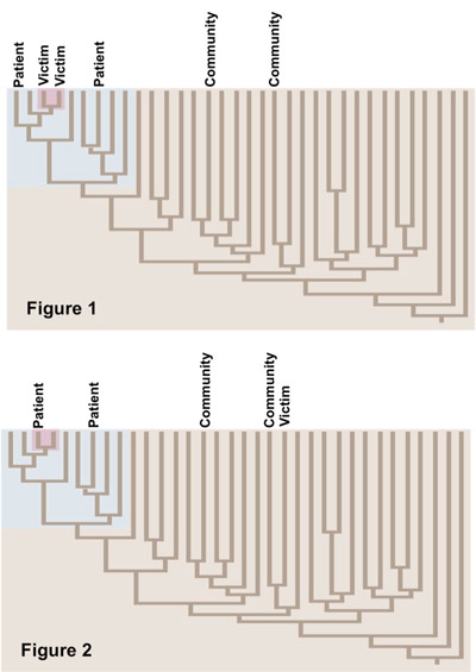Multiple Choice
The figures show alternative phylogenies of HIV strains in a victim who was infected with HIV+ blood and in potential sources of the blood (the patient) and HIV strains in members of the community. Choose the true statement(s) about the evolution of this HIV strain.
A) Figure 1 supports that the victim contracted HIV from the patient, and Figure 2 supports that the victim contracted HIV from someone in the community.
B) Figure 1 supports that the victim contracted HIV from someone in the community, and Figure 2 supports that the victim contracted HIV from the patient.
C) Figure 1 supports that the HIV strain mutated into a new strain inside the victim's body, and Figure 2 supports that HIV did not mutate into a new strain inside the victim's body.
D) Figure 1 supports that the HIV strain did not mutate into a new strain inside the victim's body, and Figure 2 supports that HIV mutated into a new strain inside the victim's body.
Correct Answer:

Verified
Correct Answer:
Verified
Q1: <img src="https://d2lvgg3v3hfg70.cloudfront.net/TB10957/.jpg" alt=" -Based on the
Q2: Which of the following are properties of
Q3: One day after a biology class four
Q4: There are many features that distinguish bacteria
Q5: <img src="https://d2lvgg3v3hfg70.cloudfront.net/TB10957/.jpg" alt=" -Indicate the phylogenies
Q7: <img src="https://d2lvgg3v3hfg70.cloudfront.net/TB10957/.jpg" alt=" The figure shows
Q8: Identify the polyphyletic group.<br>A) Chloroplasts<br>B) Eukarya<br>C) Bacteria<br>D)
Q9: What can you conclude by the observation
Q10: Most infectious disease in humans are caused
Q11: Choose the true statement about the morphological